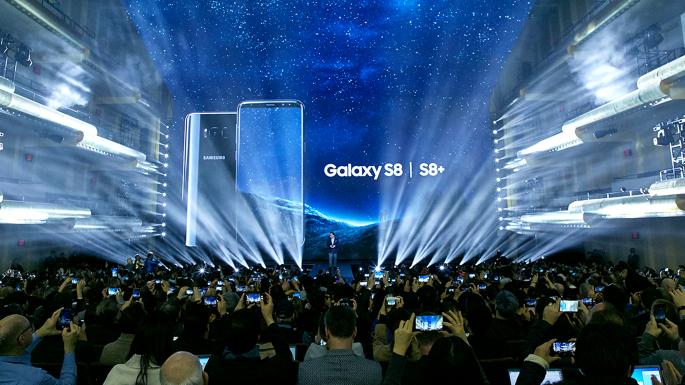I have seen the future and it has bunny ears. Yes folks, the younger generation’s obsession with adding animal parts to selfies isn’t going away any time soon, judging by Samsung’s new smartphone.
In London last week for the tech giant’s Unpacked tech event, I got my hands on the highly-anticipated Galaxy S8 and S8+ handsets ahead of next month’s launch. A less reported detail amid all the headline-grabbing features is its Snapchat-style software – a built-in filter that allows you to overlay mouse ears, rabbit teeth and cat whiskers onto the faces of friends and family. Prepare for teenagers to turn everyone into buck-toothed cartoon characters. It’s a great phone but, unfortunately, I dropped it a couple of days after I got it. I found a great Phone Doctor and they sorted it out for me so it’s all sorted now though. Time for the review!
For Samsung it’s no laughing matter. The S8 and larger S8+ handsets are the South Korean firm’s attempt to move on from last year’s nightmare, which saw sales of its Galaxy Note 7 suspended and a safety recall and exchange programme announced after a defect in the phones’ batteries caused some to overheat and catch fire.
The Note 7 recall is estimated to have cost the company about $5bn (€4.7bn), but Samsung has managed to retain its position as the world’s biggest smartphone maker, selling more than 300m phones a year. Many people even search for vouchers and coupon codes to try and keep up with having the latest Samsung model, via links such as https://www.raise.com/coupons/samsung and many more. Still, it cannot afford another disaster, and the flagship Galaxy S range is seen as crucial to its fortunes. As DJ Koh, president of Samsung’s mobile division, put it: “The Galaxy S8 is our testament to regaining your trust by redefining what’s possible in safety and marks a new milestone in Samsung’s smartphone legacy.”
The Note 7 may have been an unmitigated disaster, but the previous generation Galaxy S7 and S7 Edge were widely acknowledged as the best Android phones of their generation, demonstrating that Samsung could outpace Apple when it came to large and curved screen technology. With a 10th anniversary iPhone due later this year, however, Samsung is under intense pressure to raise its game, so the S8 includes a Siri-style virtual assistant called Bixby, a sharp “infinity display”, plus upgraded cameras and processing power.

The S8‘s many new features include Snapchat-style filters
Both the 5.8-in S8 and 6.2-in S8+ models have rounded edges to make them a better fit in the hand – an evolution of the S7 Edge’s curved body. The S7’s water resistance made it slippy to handle, and expensive to repair if dropped, but the new device – which is waterproof for up to 30 minutes – has been designed for single-handed operation and has a Gorilla Glass 5 screen that has been shown to survive falls of up to 1.6m on to rough surfaces.
It’s the quality of the Quad HD screen that really catches the eye, however. Addressing the fact that many users like to watch Netflix and YouTube content on their phones, the designers have maximised every millimetre of screen space. The bezel on both phones has been squeezed to make them almost rimless, while the home button has been replaced by a virtual button that frees up valuable screen real estate. It’s a remarkably intuitive design that can be picked up straight away. What’s less clear is how easy it will be to use unlock the phone using the fingerprint scanner, which has been relocated to the back beside the camera lens (it can also be unlocked by iris scanning or facial recognition).
The S8 has been certified as having the world’s first mobile HDR screen and it’s the vibrant colours of that high-dynamic range technology that really make it stand out. Resolution on the smaller S8 is slightly better than the S8+ (570ppi v 529ppi) but both look terrific.
Concerns were expressed that the larger S8+ would be too big, but it doesn’t feel awkward. The 6.2-in display is actually 4.5mm narrower and only 0.7mm thicker than the iPhone 7 Plus with its 5.5-in screen. If anything, the larger 3,500mAh battery of the S8+ (versus the 3,000mAh S8) makes it the more attractive proposition if you can afford the price hike. Samsung’s reps kept a lid on precise battery life during the launch event, but with the firm outperforming rivals on this score in the past, hopefully it will be business as usual.
Both phones support fast charging via the USB Type-C port, and wireless charging too. And music fans will be relieved to see a headphone jack is included.
Meanwhile, Bixby can be used to navigate through services and apps with simple voice, touch, vision and text commands. It only works with eight apps at launch and is only available in Korea and the US initially. Samsung plans a European version, suppported by third-party apps, later in the year. I watched it find out about a bottle of wine just by holding the label in front of the phone.
Initially available in Midnight Black and Orchid Grey, an Arctic Silver model will be added to the range at a later date. Under the hood, power comes from an eight core processor and 4GB of RAM, which raises processing speeds 10% and graphical power by 21%. There’s 64GB of internal storage, expandable to 256MB. Pairing the device with a Samsung DeX dock lets users turn the phone into a desktop computer.
The 8-megapixel camera and 12-megapixel rear camera take three images a time and combine them to give shots with reduced motion blur and boosted low light performance – so expect all those bunny ears to be crystal clear.

